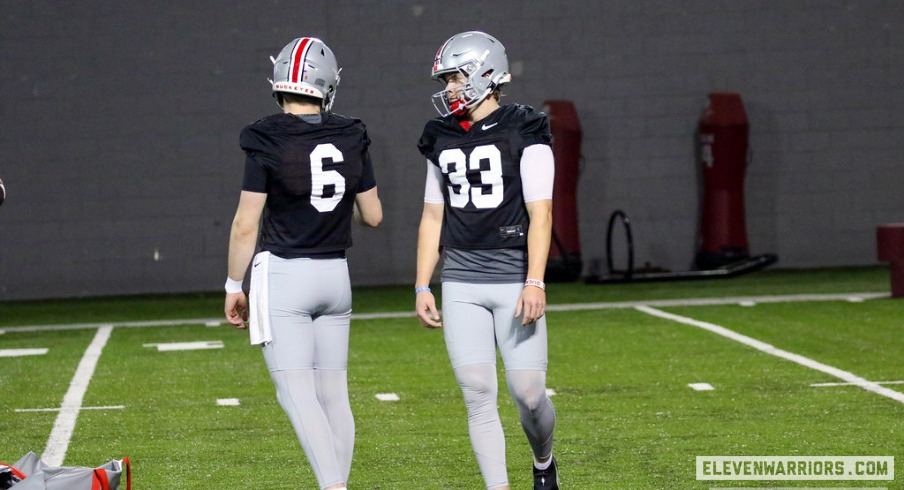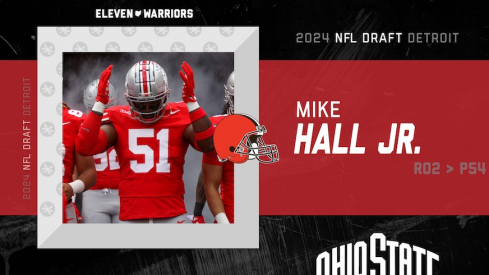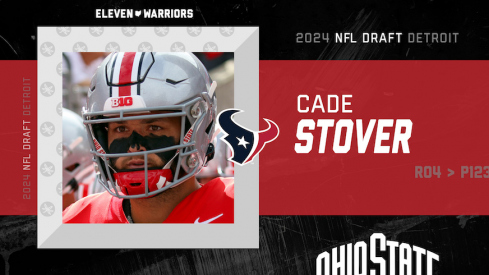Having a quarterback with experience used to be vital for success on the biggest stage in college football.
That doesn't seem to be the case anymore. While having a signal-caller with experience is certainly a plus when it comes to the most important position in football, experience isn't the be-all, end-all in a day and age where younger athletes are more prepared than ever to compete at a high level.
Whether it's Kyle McCord – who was named the starting quarterback for the season opener at Indiana – or Devin Brown, Ohio State will have a first-year starter behind center this season. Following in the footsteps of Dwayne Haskins, Justin Fields and C.J. Stroud certainly won't be easy, but expectations for the Buckeyes will be sky-high even with a new face leading the offense.
With an offense that features the nation’s most loaded group of skill players – TreVeyon Henderson, Miyan Williams, Marvin Harrison Jr. and Emeka Egbuka, among others – the first-year QB1 doesn't have to be a star, McCord or Brown just have to do enough to allow the rest of the offense to flourish.
History has proven that having a first-year starting quarterback isn't unchartered territory for teams who make the College Football Playoff, let alone the national championship. With Ohio State having a first-year starting quarterback, we take a look back at the previous first-year starters who have led their respective team to the CFP since it debuted in 2014.
| Year | Player | School |
|---|---|---|
| 2014 | J.T. BARRETT AND CARDALE JONES | OHIO STATE |
| 2014 | BLAKE SIMS | ALABAMA |
| 2015 | JAKE COKER | ALABAMA |
| 2016 | JALEN HURTS | ALABAMA |
| 2017 | JAKE FROMM | GEORGIA |
| 2017 | KELLY BRYANT | CLEMSON |
| 2018 | KYLER MURRAY | OKLAHOMA |
| 2018 | TUA TAGOVAILOA | ALABAMA |
| 2018 | TREVOR LAWRENCE | CLEMSON |
| 2019 | JUSTIN FIELDS | OHIO STATE |
| 2020 | MAC JONES | ALABAMA |
| 2021 | BRYCE YOUNG | ALABAMA |
| 2021 | CADE MCNAMARA | MICHIGAN |
| 2022 | J.J. MCCARTHY | MICHIGAN |
Some interesting tidbits:
- Of the 36 teams that have made the CFP since it debuted in 2014, 14 have featured a first-year starting quarterback.
- Of those 14, 10 made the national title game, with four winning the national championship.
- A first-year starting signal-caller has made the CFP in all of the 10 seasons since it debuted in 2014.
2022: J.J. McCarthy, Michigan
McCarthy split time early on with McNamara while Jim Harbaugh and company needed time to decide on QB1, but he inevitably won the job and never looked back. After throwing for 516 yards as a freshman, he completed 64.6% of his passes for 2,719 yards, 22 touchdowns and five interceptions last season. He also ran for 306 yards and five touchdowns during his sophomore campaign.
His first season leading Michigan's offense concluded with a Big Ten title and a 51-45 loss to TCU in the CFP semifinal.
2021: Cade McNamara, Michigan
Taking over for Joe Milton, who then transferred to Tennessee, McNamara completed 210 of 327 passes for 2,576 yards and just 15 touchdowns and six interceptions as a sophomore. He led the Wolverines to a Big Ten title but Michigan lost to eventual national champion Georgia in the CFP semifinal.
2021: Bryce Young, Alabama
In a Heisman Trophy-winning season that concluded with losing in the national championship game to Georgia, Young showed out in his only season leading Alabama's offense. As a sophomore, he completed 66.9% of his passes for 4,872 yards, 47 touchdowns and seven interceptions. Besides Young, the Crimson Tide's offense was led by Jameson Williams, John Metchie and Brian Robinson Jr.
2020: Mac Jones, Alabama
Although he didn't become a full-time starter until his junior season, he gained plenty of experience during his first two years in Tuscaloosa while backing up Tua Tagovailoa and Jalen Hurts. Jones completed 102 of 154 passes for 1,626 yards and 15 touchdowns, with much of that coming in spot duty during his sophomore campaign in 2019.
Jones then completed 311 of 402 passes (77.4%) for 4,500 yards, 41 touchdowns and four interceptions during his lone season as the full-time starter including 464 yards and five touchdowns against Ohio State in the CFP final.
While finishing third in Heisman Trophy voting, the junior led an Alabama offense that included Heisman winner DeVonta Smith, Najee Harris, Jaylen Waddle and John Metchie. Alabama went 13-0 and won the national championship. Jones was then selected in the first round of the 2021 NFL draft following his only season as the full-time starter.
2019: Justin Fields, Ohio State
After transferring to Ohio State from Georgia, Fields had a superb sophomore season that featured completing 67.2% of his passes for 41 touchdowns and three interceptions and also 484 yards and 10 touchdowns on the ground. The Buckeyes lost to Clemson in the CFP semifinal.
2018: Trevor Lawrence, Clemson
After taking over Kelly Bryant to lead Clemson's offense as a freshman, Lawrence threw for 3,280 yards, 30 touchdowns and four interceptions while completing 259 of 397 passes.
With a stout defense and an offense that included Tee Higgins, Justyn Ross and Travis Etienne, the Tigers finished 15-0 and won the national championship while completing two blowouts over Notre Dame and Alabama in the CFP.
2018: Tua Tagovailoa, Alabama
After the left-hander made a second-half relief performance – completing 14 of 24 passes for 166 yards – to lead Alabama to a national title the season prior, Tagovailoa was given the keys to the Crimson Tide's offense in 2018.
In his first season as the full-time starter, Tua completed 69% of his passes for 3,966 yards, 43 touchdowns and six interceptions and ran for 190 yards and five touchdowns in a season he finished second in the Heisman race. Tagovailoa's receiving corps during his junior season included Jerry Jeudy, Henry Ruggs III and Waddle.
2018: Kyler Murray, Oklahoma
In a junior campaign that featured Murray completing 69% of his passes for 4,361 yards, 42 touchdowns and seven interceptions while also running for 1,001 yards and 12 touchdowns, the do-it-all quarterback won the Heisman Trophy at season's end. Murray led Oklahoma to the CFP, where it lost in the semifinal to Alabama.
2017: Kelly Bryant, Clemson
Bryant attempted just 18 passes during his first two seasons at Clemson, but he threw for 2,802 yards, 13 touchdowns and eight interceptions while completing 65.8% of his passes and running for 665 yards and 11 touchdowns as a junior. The Tigers lost to Alabama in the CFP semifinal.
2017: Jake Fromm, Georgia
After Jacob Eason was injured in the Bulldogs' season opener, Fromm took over and never gave up the starting job the rest of the season. He completed 181 of 291 passes for 2,615 yards, 24 touchdowns and seven interceptions while earning SEC Freshman of the Year honors. Georgia lost to Alabama in overtime of the national championship game.
2016: Jalen Hurts, Alabama
The dual-threat quarterback had some rough patches but proved to be a game-changer as a true freshman. Taking over for Coker, Hurts threw for 2,780 yards and ran for another 954 while totaling 36 touchdowns (23 passing, 13 rushing) and nine interceptions. The Crimson Tide lost to Clemson in the CFP title game.
2015: Jake Coker, Alabama
While he appeared in 15 games during his first three seasons (two at Florida State, one at Alabama), Coker had only 100 pass attempts before taking over as the starting quarterback as a senior at Alabama. He completed 67% of his passes in 205 for 3,110 yards, 21 touchdowns and eight interceptions while leading the Crimson Tide to a 14-1 record and a national championship during his lone season as the starting quarterback.
2014: Blake Sims, Alabama
After seeing very limited action during his first three seasons at Alabama, Sims passed for 3,487 yards, 28 touchdowns and 10 interceptions while completing 64.5% of his throws during his final collegiate season. The Crimson Tide lost to Ohio State in the CFP semifinal.
2014: J.T. Barrett and Cardale Jones, Ohio State
Buckeye Nation already knows how this turned out. After Barrett was thrown into the spotlight as a redshirt freshman following Braxton Miller's season-ending shoulder injury in fall camp, the dual-threat quarterback completed 65% of his passes for 2,834 yards, 34 touchdowns and 10 interceptions. Barrett also ran for 938 yards and 11 touchdowns as well.
Jones then took over after Barrett suffered a season-ending ankle injury against Michigan in Ann Arbor. Although he only had 19 career pass attempts through nearly two full collegiate seasons, he led Ohio State to a dominant 59-0 over Wisconsin in the Big Ten title game to secure a spot in the inaugural CFP.
In a three-game stretch as the Buckeyes' starting quarterback in an offense that included Ezekiel Elliott, Devin Smith and Michael Thomas, the gunslinger threw for 742 yards, five touchdowns and two interceptions to lead Ohio State to a national championship.


